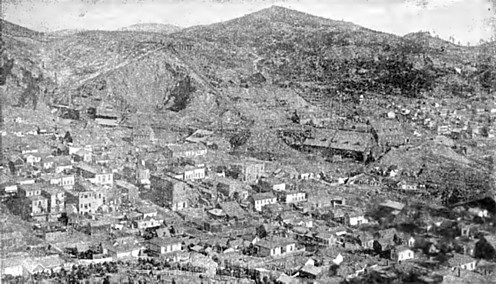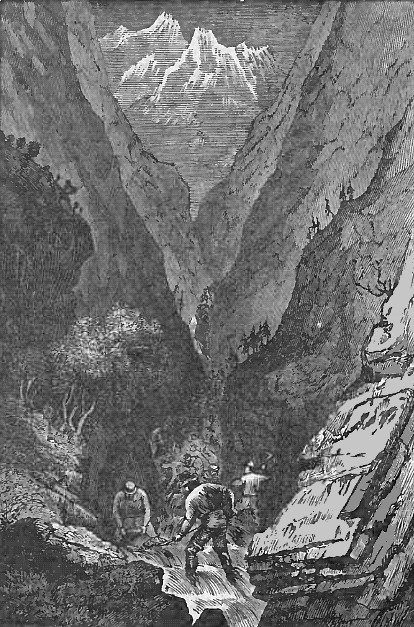Below will be found a digest of the early day mining laws of the Dakota Territory (before statehood), in connection with both general and local statutes governing the location of mineral claims, as compiled by H. N. Maguire, Esq., attorney at law, of Rapid City, Dakota. It will be found invaluable for the use of prospectors, miners, mill-men, etc.: Only citizens, and those who have declared their intention to become such, can legally locate mines. All land is mineral that is more valuable for mining than farming purposes.
A vein or lode extends one hundred and fifty feet on each side of its centre, and the end lines must be parallel with each other. Locators have the exclusive right of all the surface included within the lines of their locations, and of all veins throughout their entire depth the topsoil apices of which are inside such surface lines; but their right of possession is confined to such portions thereof as lie between vertical, planes drawn downward through the end lines of their locations no right being granted to enter upon the surface location of another. Where two or more veins intersect or cross, the prior location will take the ore within the intersection. The discoverer must record within twenty days from the date of the discovery, and his location certificate must contain (1) the name of the vein; (2) the name of the locator; (3) the date of location; (4) the number of feet in length claimed on each side of the discovery shaft ; (5) the number of feet in width claimed on each side ; (6) the general course of the vein, as nearly as may be. The discovery shaft must show a well-defined vein; a plain notice embracing the above facts must be posted at the point of discovery; the surface. The boundaries must be marked by eight substantial posts (besides discovery), hewed on the sides facing the location, and sunk in the ground, or firmly planted in monuments of stone, and arranged as shown in the accompanying diagram. Any cut deep enough to disclose the vein, or a ten-foot adit or trench along the vein from the point of discovery, would be a legal discovery shaft.
The discoverer has thirty days from the time of uncovering a vein to sink his discovery shaft. (Locators cannot exercise too much care in defining their veins at the outset.) All mining claims are subject to the right of way, for mining purposes, of any ditch or flume, tramway or pack trail in use, or that may be laid out across such location ; but such right of way shall not be exercised against any location made prior to the claim of such right of way without the consent of the claim owners, except by condemnation, as in the case of land taken for public highways; and such ditch or flume shall be so constructed as not to injure vested rights.
When the right to mine is distinct from the ownership or right of occupancy of the surface, the owner or rightful occupant of the surface may demand security from the miner; and if refused may enjoin the miner from working until such security is given. A locator may at any time amend his location by recording an additional certificate of location, in accordance with the general requirements of the mining laws, providing such relocation does not, at the time of making it, interfere with the existing rights of others. In order to hold a vein before patent issues work must be done or improvements made to the value of one hundred dollars a year ; and within six months from the year within which outlay is required to be made the person who made such outlay, or some person for him, shall make and record an affidavit of the fact ; and the recorder's certificate shall be prima facie evidence of the performance of such labor or the making such improvements. The relocation of abandoned claims shall be by erecting new boundaries and by sinking a new discovery shaft, or by sinking from the bottom of the old shaft as it were a new shaft commenced from the surface. (The safer course is to sink a new shaft.)
No location certificate can embrace more than one claim, no difference how many locators there may be. The register of deeds is entitled to one dollar and fifty cents for recording and furnishing a certified copy one dollar for the former and fifty cents for the latter. The penal code of Dakota makes it a misdemeanor, punishable by imprisonment in the county jail not less than thirty days nor more than six months, and by fine not exceeding two hundred and fifty dollars, for two or more persons, by force and violence, or by threats of violence to cause any person or persons to stop working on mining property. Mining property in Dakota is subject to laborers' liens for work performed upon it. The locators of a tunnel shall have the right of possession of all veins within three thousand feet from the face of such tunnel, on the line thereof, not previously known to exist ; and locations of veins on the line of such tunnel that do not "crop out," made after the commencement of the tunnel, and while work is being prosecuted upon it with reasonable diligence, are invalid. Locators of a tunnel must, when they enter cover, erect a substantial post or monument at the point of commencement, and post thereon notice giving (1) the names of the locators; (2) the proposed direction; (3) the height and width; (4) must specify in their notice such well-known or easily ascertained objects in the vicinity as will clearly determine the extent and course of the tunnel when completed; and (5) at the time of posting their location notice, shall establish their boundary lines of stakes or monuments to the terminus of the three thousand feet claimed. A full and complete copy of the notice of location defining the tunnel claim, with a sworn statement of all the relating facts, and that it is the intention to prosecute the work with reasonable diligence for the discovery of veins, must be filed for record at the time of posting the notice of location. The money expended in making a tunnel is considered as expended upon veins struck in such tunnel.
Upon the failure of one of several co-owners to contribute his proportion toward the development of mining property, those who have so contributed may, at the expiration of the year, give the delinquent personal notice in writing or by publication in the newspaper nearest said property at least once a week for ninety days, and if the delinquent should fail to contribute his proportion within ninety days from the service or first publication of such notice, then his interest in the property shall become the property of his co-owners who have made the required expenditures. When labor or improvements to the amount of five hundred dollars shall have been performed or made upon a vein patent may be applied for. Notice of such application must be published for sixty days, at the expiration of which time, if no adverse claim shall have been filed, it will be assumed that the applicant is entitled to a patent, upon making the necessary proofs and paying the receiver of the district office the official fees and five dollars per acre. [The preliminaries of obtaining a patent are somewhat complex, and exactness is required in detail, whereof the applicant had better secure the services of an attorney who makes a specialty of such business.]
Placer mining claims may be patented at two dollars and fifty cents per acre, or at that rate for fractional parts of an acre, under like circumstances and conditions, and upon similar proceedings, as are provided for veins; but no placer gold nugget location can embrace more than twenty acres for each individual claimant, or more than four hundred and sixty acres in one application. A patent for a placer claim conveys any vein embraced which was not known to exist when the patent was applied for; but when a mineral vein is known to be embraced in the placer tract at the time of making application the fact must be distinctly stated, when the patent will issue including such vein upon the applicant paying five dollars per acre therefore, including twenty-five feet of surface ground on each side thereof.
Owners of quartz mills and reduction-works, as well as quartz mine claimants, can claim not to exceed five acres of non-mineral land for a mill site upon making the required proofs, and paying five dollars per acre for the property. Mill sites may be applied for along with applications for mines with which they may be connected. Water-rights for mining purposes vest by priority of possession; and all patents granted are subject to such vested rights. If an adverse claimant does not commence suit within the proper time from the dishonesty of his attorney, the irregularity of the mails or any other cause he has no redress through the Interior Department. Contestants may compromise, and then a new survey will be ordered conforming with the lines agreed upon by the compromise. Deposits of borax, auriferous cement, copper, diamonds and other precious stones, fire-clay, iron, kaoline, limestone, marble, mica, petroleum/ plumbago, slate, salt springs, sulfur, umber, etc., may be patented under the mining laws upon proof, in each specified case of the land being more valuable for the mineral specified than for agricultural purposes. What is found in vein deposits must be entered under the provisions of the law governing veins, or " rock in place ;" other deposits may be entered under the provisions of the law governing the entry of gold placers.
Return
to The South Dakota Page:
South Dakota Gold Rush History



